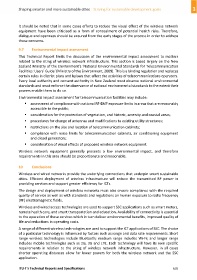Page 645 - Shaping smarter and more sustainable cities - Striving for sustainable development goals
P. 645
It should be noted that in some cases efforts to reduce the visual effect of the wireless network
equipment have been criticized as a form of concealment of potential health risks. Therefore,
dialogue and openness should be ensured from the early stages of the process in order to address
these concerns.
9.7 Environmental impact assessment
This Technical Report limits the discussion of the environmental impact assessment to matters
related to the siting of wireless network infrastructure. This section is based largely on the New
Zealand Ministry of the Environment’s ‘National Environmental Standards for Telecommunication
Facilities: Users’ Guide’ (Ministry of the Environment, 2009). This is a binding regulation and replaces
certain rules in district plans and bylaws that affect the activities of telecommunications operators.
Every local authority and consent authority in New Zealand must observe national environmental
standards and must enforce the observance of national environmental standards to the extent their
powers enable them to do so.
Environmental impact assessment for telecommunication facilities may include:
assessment of compliance with national RF‐EMF exposure limits in areas that are reasonably
accessible to the public;
consideration for the protection of vegetation, and historic, amenity and coastal areas;
procedures for change of antennas and modifications to existing utility structures;
restrictions on the size and location of telecommunication cabinets;
compliance with noise limits for telecommunication cabinets, air conditioning equipment
and diesel generators;
consideration of visual effects of proposed wireless network equipment.
Wireless network equipment generally presents a low environmental impact, and therefore
requirements in this area should be proportionate and reasonable.
10 Conclusions
Wireless and wired networks provide the underlying connections that underpin smart sustainable
cities. Efficient deployment of wireless infrastructure will reduce the transmitted RF power in
providing services and support greater efficiency for ICTs.
The design and deployment of wireless networks must also ensure compliance with the required
quality of service as well as with standards and regulations on human exposure to radio frequency
(RF) electromagnetic fields.
Wireless and wired access technologies are used to support SSC applications such as smart meters,
remote health care, and smart transportation and education. Availability of connectivity is essential
to the operation of these services which in turn deliver environmental benefits, improved quality of
life and reductions in operating costs.
A range of different wireless technologies are used to support the ICT applications of SSC. The choice
of a particular technology is influenced by factors such as range and data rate requirements. Short
range wireless technologies include Bluetooth; medium range includes Wi‐Fi; and longer range
includes mobile technologies such as 2G, 3G and LTE. Each technology will have its own specific
requirements in relation to the siting of wireless network infrastructure. However, in all cases
shorter operating distances allow for lower powers for both the wireless network and the SSC
application.
ITU‐T's Technical Reports and Specifications 635

